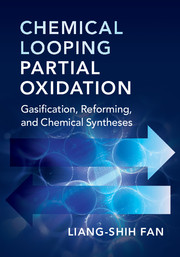Book contents
- Frontmatter
- Dedication
- Epigraph
- Contents
- In Cooperation with Professor Fan's Research Group Members
- Preface
- Nomenclature
- Abbreviations
- 1 Overview
- 2 Metal Oxide Oxygen Carriers
- 3 Oxidative Coupling of Methane
- 4 Syngas Generation
- 5 Catalytic Metal Oxides and Applications
- 6 Process Simulations and Techno-Economic Analyses
- Index
- Color plate section
4 - Syngas Generation
Published online by Cambridge University Press: 07 November 2017
- Frontmatter
- Dedication
- Epigraph
- Contents
- In Cooperation with Professor Fan's Research Group Members
- Preface
- Nomenclature
- Abbreviations
- 1 Overview
- 2 Metal Oxide Oxygen Carriers
- 3 Oxidative Coupling of Methane
- 4 Syngas Generation
- 5 Catalytic Metal Oxides and Applications
- 6 Process Simulations and Techno-Economic Analyses
- Index
- Color plate section
Summary
Introduction
Syngas, predominantly a mixture of H2 and CO, is an important feedstock for the production of many valuable commodity chemicals such as methanol, synthetic liquid fuels, ammonia, and hydrogen. Since syngas forms the backbone of many chemical industries, its purity, H2:CO ratio, and cost have a major effect on the operation and economics of downstream chemical processing systems. Over the years, the process of syngas production has evolved from simply passing steam over hot coke to the use of large-scale solid circulating units that process a variety of hydrocarbon feedstocks. Some syngas production processes have been used at the commercial scale while others are still being developed at the lab and bench scale. Considerable knowledge has been gained from large-scale operations, and these have been valuable in paving the way for further innovations and new technologies development.
Gasification and reforming are the two processes that form the basis of all syngas production technologies. Syngas production technologies involve the use of oxidative reagents like oxygen, steam, CO2, and more recently metal oxide oxygen carriers, to selectively convert various hydrocarbon feedstocks to syngas. The term “selective” is significant since the formation of full combustion products, CO2 and H2O, is undesirable. Therefore, careful consideration is required when selecting operating conditions like temperature, pressure, catalyst, and/or metal oxide oxygen carriers. The ultimate goal for generating syngas is a process that is simple in operation and low in energy and cost requirements. For operation with metal oxides, as in chemical looping processes, combustion applications have been studied extensively. Relatively little has been probed on chemical looping gasification and reforming. There is a distinct difference in operating strategy between chemical looping gasification/chemical looping reforming (CLG/CLR) and chemical looping combustion (CLC) processes. The CLC processes can achieve a complete reactant gas oxidation with a low reactant gas to oxygen carrier ratio. The CLG/CLR processes, on the other hand, can achieve a partial or selective reactant fuel oxidation with a high reactant fuel to oxygen carrier ratio.
In this chapter, syngas generation technologies based on conventional processes and chemical looping processes are discussed. Specifically, Section 4.2 provides a historical viewpoint on the development of current commercial-scale syngas generation processes. An account of each of the technologies followed by examples of their application in commercial operation is given.
- Type
- Chapter
- Information
- Chemical Looping Partial OxidationGasification, Reforming, and Chemical Syntheses, pp. 236 - 306Publisher: Cambridge University PressPrint publication year: 2017



